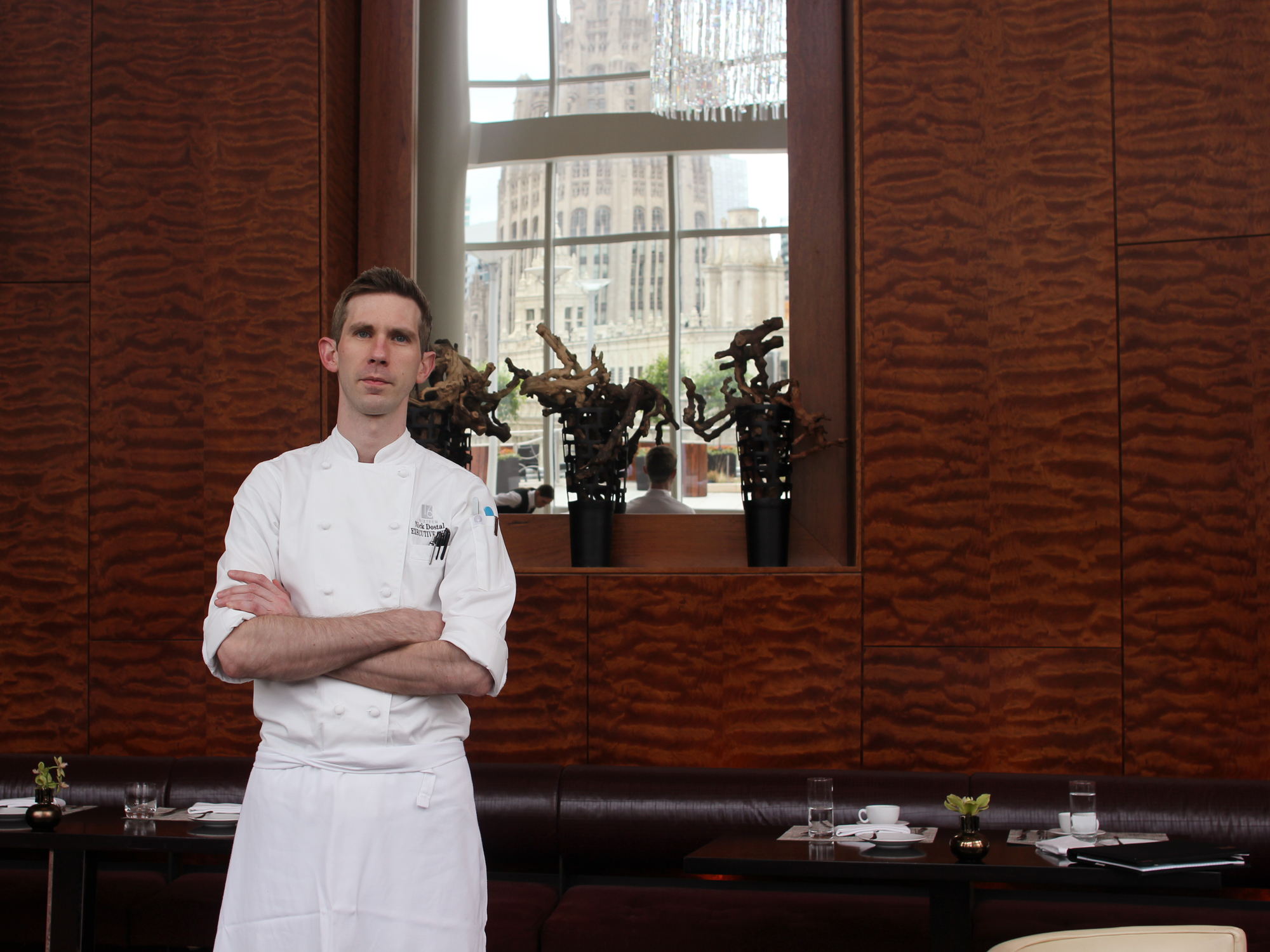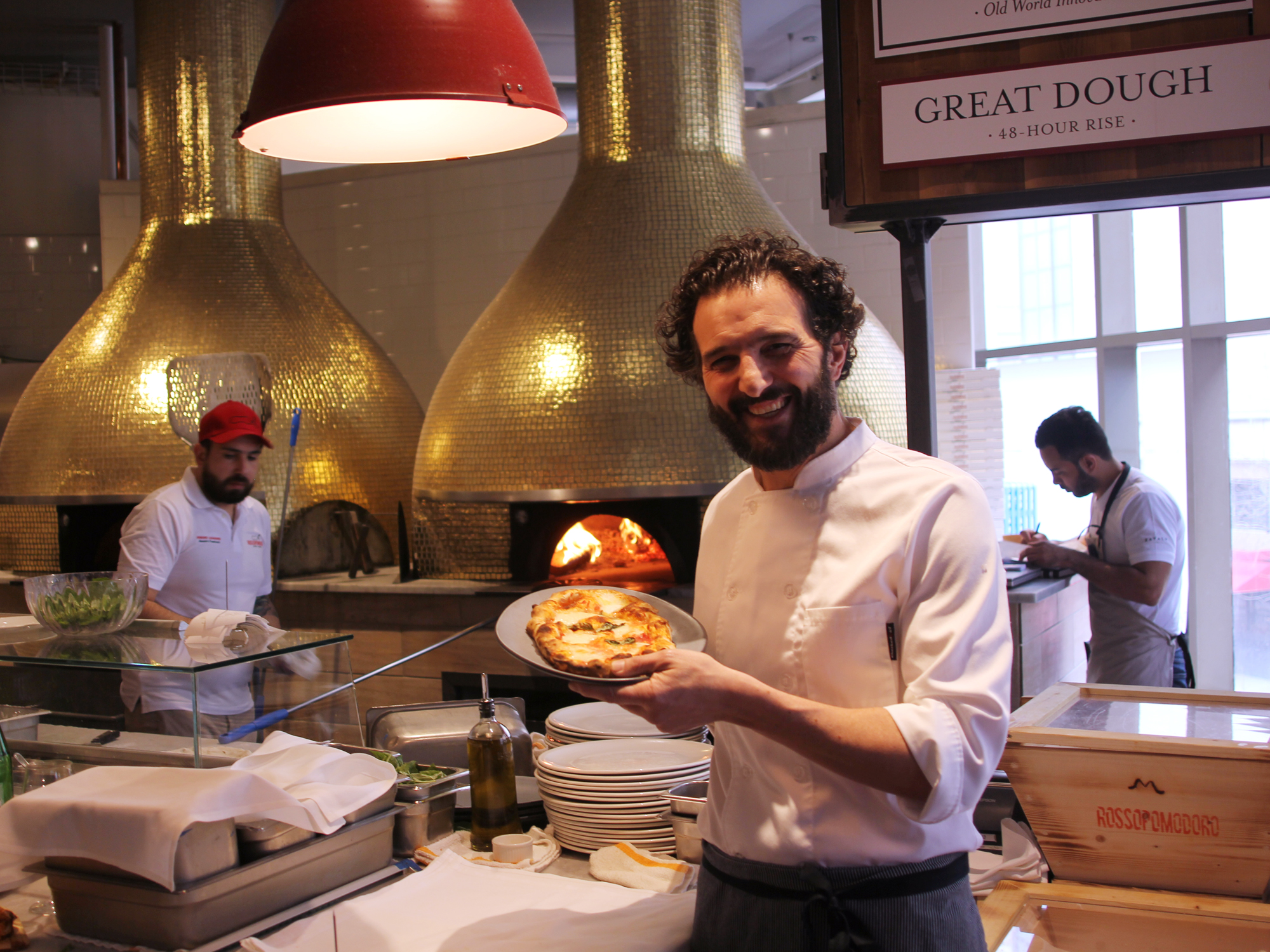WHILE I WAS LEARNING ABOUT EATALY’S NEW dough formulations a few weeks ago, Jason Hammel of Lula Cafe was in the house working on his special pizza for Italy’s guest pizzaolo series, Quattro Mani. Each Tuesday, they have a guest chef whose recipe will be offered for the week, with a portion of the proceeds on the first night going to the charity of his or her choice.
Gee, that would be cool to do, I thought, since I make artisan-ish pizzas at home all the time and even have a couple of gadgets for attempting to do Neapolitan pizzas on the Weber grill. I thought of suggesting myself as a future guest chef.
Then I looked at the people who they’ve had in to do it—Sarah Grueneberg, Abe Conlon, John Manion… yeah, I may know these people but I’m not one of them. I had lunch recently with a chef who just retired, and he had caustic words for people who dare to use the C-word for themselves when they just know how to make one kind of thing, and haven’t learned how to brunoise vegetables and make perfectly clear stock and all the other things that make a chef a chef. My last professional experience in a kitchen was Mcdonald’s in high school. I’m just a home cook. A home pizza maker. I would not presume.
Then they asked me anyway.
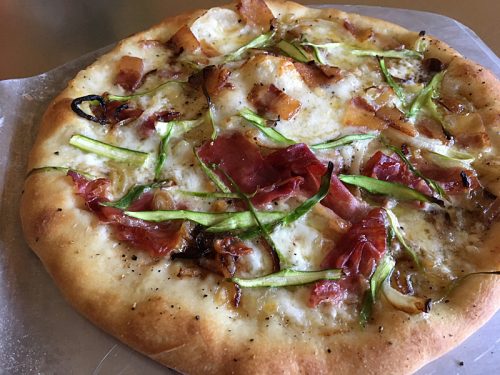
Test pizza #1
ONE THING I THOUGHT ABOUT WHEN I WAS tasting Eataly’s new doughs was a classic Alsatian dish, known as flammkuchen to the German speakers and tarte flambée to the Francophones. It’s basically cooked like a pizza, but it has some kind of creamy farmer cheese on the crust, onions and bacon. Simple, perfect. When you see it on a menu and think they will do it right, order it. The crust sometimes has a hint of rye or something to it, and the slight whole wheat nuttiness of the “Rustico” dough reminded me of that.
So my idea was to do an Italian variation on tarte flambée. I went to a grocery store in my neighborhood and bought some La Quercia speck (a cured, slightly smoked meat similar to prosciutto) and a few different cheeses. I made two pies, each dotted with half speck and half home-made guanciale, the first with a burrata, the second with a slightly stronger soft cheese. Other than that, they had olive oil, some cracked black pepper, some yellow onion and some shaved asparagus—it’s spring, all the chefs use asparagus now. (I drew the line at ramps. I would not presume.) When they came out of the oven, I drizzled them with some honey.
The verdict: not bad, but a bit bland. It needed more flavor. As Coach used to say, you can’t spell pizza without almost spelling pizzazz.
I briefly thought about adding some sriracha to the honey, then decided that was getting close to flailing about adding trendiness for trendiness’ sake. Go down that route and pretty soon you’re doing Alsatian kimchi and putting uni on your Hawaiian pizza.
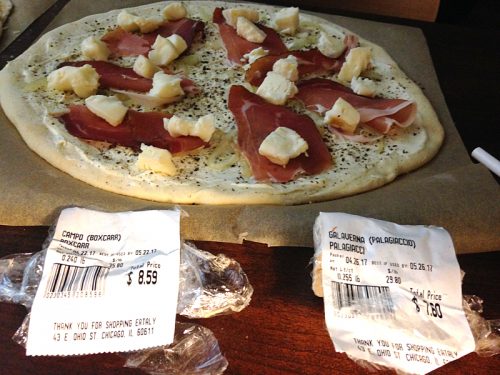
Round 2 A-B testing of two Eataly cheeses
Instead I decided to upgrade the ingredients. I love La Quercia’s speck, but it’s deliberately mild, for eating on its own; Herb Eckhouse once told me that the first time he made speck, he picked up the meat and simply walked it through the smokehouse without stopping. But for a pizza I wanted something with a heartier, saltier cured meat taste. I also found some cheeses with a little more pungency to them. And going back to tarte flambée’s original principles, I bought some Vermont Creamery creme fraiche, to serve as the farmer cheese-like base.
Both pizzas from round two were a big improvement and would have worked fine, but my family agreed that the one utilizing a mildly stinky cheese called Galaverna Palagiaccio was the winner. I had my recipe and submitted it to Eataly’s PR contact, dubbing it pizza Fiamma—an Italian translation of tarte flambée.
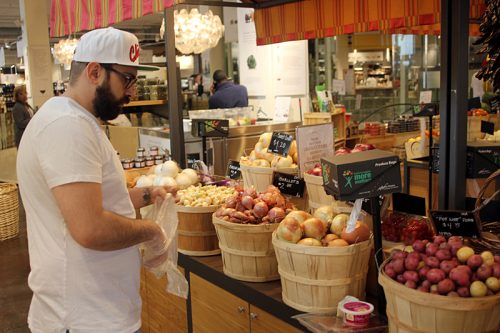
Simone Iavarone
I ARRIVED AT EATALY AROUND 2:00 PM one day last week to test out my recipe in the real pizza crucible—Rossopomodoro, Eataly’s pizza counter. The after effects of a busy lunch were evident in the kitchen, as they cleaned up the stuff that goes flying everywhere during the rush. I met Simone Iavarone, who’d been working in the background making the pizzas when I was talking to the other Simone, Simone Falco, a few weeks earlier.
If it seems confusing that there were two men named Simone in the same kitchen, actually it’s more confusing than that—Simone I. explained that they’ve worked together for some years as part of a Rossopomodoro crew opening the restaurants in places like London and Birmingham, and that they would all live together in an apartment while they opened the restaurants. I asked Iavarone if he was from Naples, too, and he said no, a small town closer to Rome. “But I’ve worked with Neapolitans for fifteen years. We always spoke Italian in the house. When I was in London, my mother would call me and she’d say, you’re supposed to be learning English, and you’re becoming Napoli instead!”
Our first step was to shop the store—to pick up the ingredients I’d used:
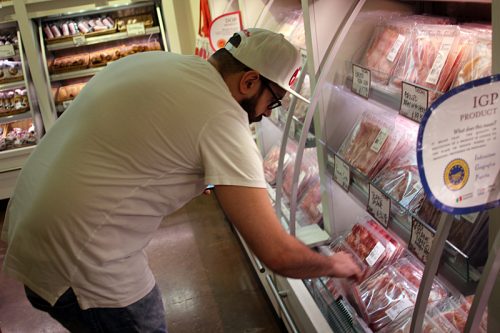
Then I watched as Iavarone assembled my recipe. He put some onions in the oven to cook them a bit before using them on the pizza:
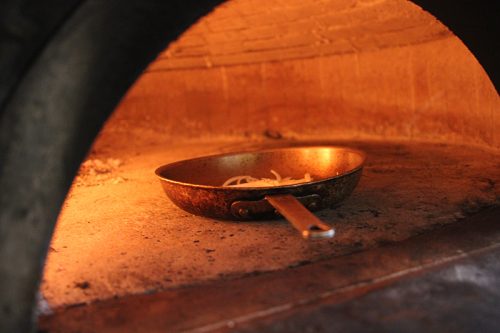
Creme fraiche with cracked pepper:
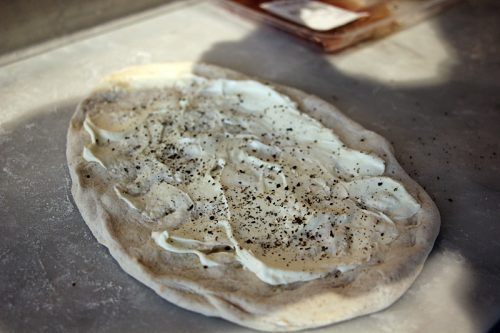
Add onions, the speck and some torn hunks of the cheese:
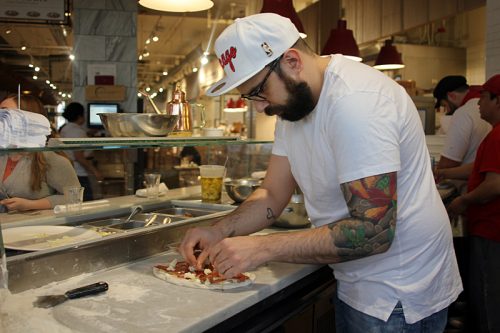
The blanched asparagus, and then a drizzle of olive oil—the only addition to my recipe:
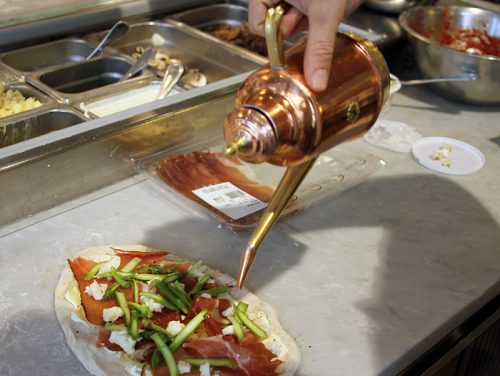
In it goes:
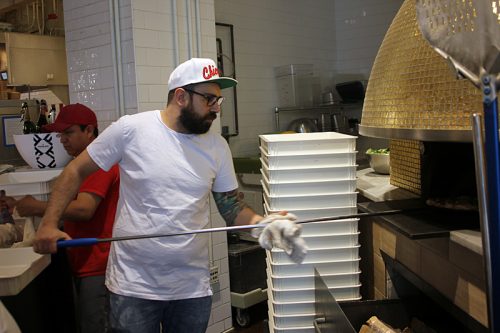
And a few minutes later, out it comes:

A final drizzle of Miel Thun honey:
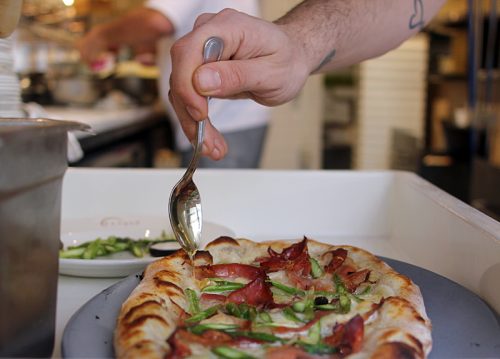
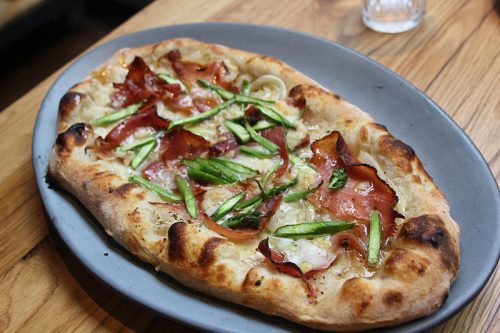
The general agreement was… pretty tasty. There didn’t seem to be anything that needed tweaking; I may not be a chef or even close to one, but at least I’ve learned a couple of things from them (use good ingredients, keep it simple stupid). Thinking everything can be improved, I pushed Simone for enhancements, but he shrugged and said “the honey cuts through the creaminess of the cheese, you’ve got a little bit of green on there—it’s good, no?”
Then the question was, what wine? Lee Salzman, wine director for Eataly, brought out a few different white wines. I felt, with the creaminess and the cheese, it needed a wine with a little acid to cut through it. A wine from Lazio called Este! Este!! Este!!!, part of their Roman food promotion this month, seemed the best of the bunch. And at $10 a glass, the Tuesday night pairing (two Neapolitan pizzas, plus a glass of wine) would come to $28, a pretty reasonable price.
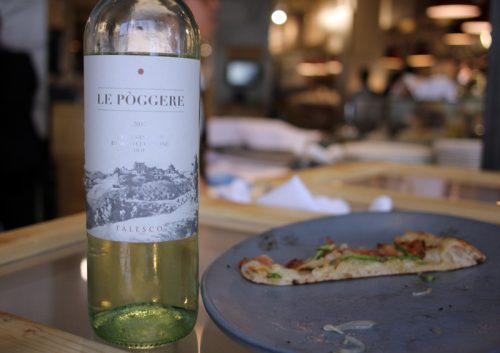
But you’ll get the chance to decide if it’s good for yourself next week at the pizza counter at Eataly. The first night, I’ll be there, helping make the pizzas; you’ll get a smaller version of my pizza with Simone’s carbonara pizza, and $10 from every pizza pairing will go to Friend of Fooditor Family Farmed, presenters of the Good Food Festival. You can make a reservation here, or walk in. Come by, say hi, bring your Fooditor 99 to get it autographed, whatever—it’ll be la dolce vita, baby. Then the full size version will be available until the next Tuesday, when another guest chef (or not-chef in my case) will be up.
So join us Tuesday, or come by any time during the next week. Many other chefs and local food personalities, from Paul McGee of Lost Lake and Beverly Kim of Parachute to Fooditor contributor Joe Campagna, will be guest pizzaolos this summer; see the whole list here.
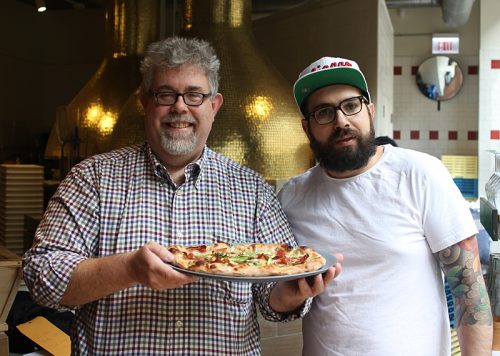
The author and the real pizzaiolo
Michael Gebert is editor! editor! of Fooditor.
Latest
Join the Discussion
After you comment, click Post. If you're not already logged in you will be asked to log in or register with Disqus.





